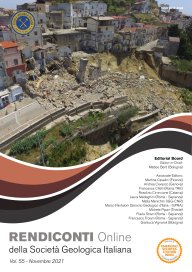

UAV-UGV imagery for disaster scenario mapping: aerial-terrestrial data fusion and comparison
Ettore Potente (1), Cosimo Cagnazzo (1), Andreas Vött (2), Alessandro Deodati (3) & Giuseppe Mastronuzzi (1)
(1) Department of Earth and Geo-environmental Science, University of Bari – 70126 Bari. (2) Institute of Geography, University of Mainz – 55128 Mainz (Germany).
(3) Niteko S.r.l. – 74020 Montemesola (TA).
Corresponding author e-mail: ettore.potente@uniba.it
DOI: https://doi.org/10.3301/ROL.2021.10
Volume: 55/2021
Pages: 10-19
Abstract
This paper introduces a mobile robotic system equipped with RBG (Red, Green, Blue) and IRT (InfraRed Thermography) sensors, designed in a joint industrial research project, which aims to develop low-cost technologies for the survey of dangerous scenarios in remote mode. The methodology adopted for mapping a landslide scenario, based on aerial and terrestrial unmanned systems, is presented. The UAV (Unmanned Aerial Vehicle) has been employed to map the damaged buildings and the landslide slope, by planning ten survey missions; the UGV (Unmanned Ground Vehicle) has been employed as a complementary mobile photogrammetry technique to obtain high- resolution ground data, by planning three missions, each consisting of two passes along the same paths simulating a two-camera setting. UAV and UGV-derived datasets have been processed using the Structure-from-Motion technique in order to obtain photogrammetry products such as ortho-photomosaics, digital terrain models, point clouds and 3D models of the building. Aerial and terrestrial models have been integrated, using GCPs (ground control points) coordinates and natural/artificial control points, and have been exploited for the spatial analysis.
An accuracy assessment has been carried out in CloudCompare using the Cloud-to-Cloud function and local modelling: the aerial and terrestrial models of buildings facades have been independently compared with a reference model, obtained from a stationary photogrammetry survey. The results highlight the higher reliability of the terrestrial model for accurate surfaces reconstruction, proving the potential of terrestrial mobile photogrammetry as an effective low- cost mapping solution for hazardous environments. Moreover, UGV mission settings, datasets characteristics and potential improvements are discussed in order to portray the benefits and limitations of this approach.
Keywords
Get Full Text